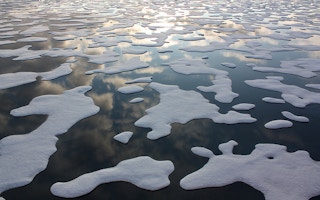Thirty-five years ago, as part of a global expedition, Charles Burton and I traveled across the Arctic Ocean via the North Pole, camping for three months on a fast-moving ice floe. It was, for us, a journey that defined our lives, and formed one leg of an enduring world record.
To continue reading, subscribe to Eco‑Business.
There's something for everyone. We offer a range of subscription plans.
- Access our stories and receive our Insights Weekly newsletter with the free EB Member plan.
- Unlock unlimited access to our content and archive with EB Circle.
- Publish your content with EB Premium.
But another record, this one far less stable, belongs to the Arctic ice itself: by March of this year, it had shrunk to the smallest size ever recorded.
The disappearance of polar ice is driven by the use of fossil fuels, which not only underpins global warming, but also has a more immediate effect, owing to widespread reliance on heavy fuel oil (HFO) to power ships. HFO is cheap and abundant, but it is also toxic and dirty.
When ships navigate the Arctic, pollutants like sulphur oxide and black carbon are deposited onto the ice and snow. The pollutant accumulation accelerates snowmelt, which warms ocean waters and, in turn, creates a self-reinforcing cycle of more melting.
The world has an opportunity to reverse these trends this week, when the Marine Environment Protection Committee of the International Maritime Organization (IMO) meets in London.
“
Alternative shipping fuels exist. Marine diesel oil and liquefied natural gas, for example, are cost effective and cleaner than HFO.
At that meeting, Canada, along with a number of Arctic and non-Arctic member states, will propose a strategy for limiting the use and transport of HFO by ships in the Arctic. It is imperative that every state in attendance supports this crucial measure to protect the fragile and fast-vanishing Arctic ecosystem.
HFO has been the “king of marine fuels” since the 1960s, but only in recent years has it come under increased scrutiny. In August 2011, it was banned from ships entering Antarctic waters, but Arctic states have been slower to move. In 2015, HFO accounted for nearly 60% of the marine fuel consumed by ships operating in the Arctic.
Economic considerations drive HFO’s popularity, but it is now widely understood that its environmental and human costs outweigh the benefits. When HFO is spilled in icy waters, it breaks down slowly and can devastate ecosystems and the livelihoods of those who depend on them.
HFO is also a significant source of air pollution. The climate warming effects of black carbon, for example, are up to five times worse in the Arctic than they are at lower latitudes.
Alternative shipping fuels exist. Marine diesel oil and liquefied natural gas, for example, are cost effective and cleaner than HFO. What’s needed is the political will to enforce a transition to less-polluting options. For now, only limited HFO bans have been enacted, such as those enforced in the Southern Ocean and the waters around the Norwegian archipelago of Svalbard.
As Arctic ice recedes, new shipping lanes will open to larger vessels, bearing the flags of a larger number of states, making HFO regulations even more important. The Arctic Council has warned that more shipping traffic will increase the risk of catastrophic oil spills.
Some countries are already taking action. In 2016, the United States and Canada announced a “phase down” in the use of HFO in vessels operating in the Arctic. Many other countries quietly support this work. But passive support is not enough.
Now that the IMO meeting is taking place, more countries must step forward and add their voice to the growing number of states calling for an HFO ban in the Arctic. The European Parliament, for its part, has already broadly supported such a move.
Momentum toward an HFO phase-out in the Arctic is building. The Danish Shipowners’ Association and the Arctic expedition cruise operator Hurtigruten are just two of the players calling for tighter regulations or an outright ban. Other shipping companies have highlighted the need for regulations to maintain a level playing field.
In January 2017, Hurtigruten joined the Clean Arctic Alliance to launch the Arctic Commitment. The initiative brings together shipping operators, polar explorers, NGOs, communities, and businesses to back an HFO phase-out, ahead of any increase in Arctic shipping, while urging the broader shipping industry to switch to alternative fuels. (I signed earlier this year.)
At this month’s Marine Environment Protection Committee meeting, IMO member states must build on the progress already made by supporting the HFO phase-out proposed by Canada. In particular, they must commit to enforcement of any resulting IMO measures, and to ensuring that the use of HFO is eventually banned from Arctic waters. We have time to append the record books on Arctic ice, but we must act fast.
Ranulph Fiennes is an English explorer, writer, and author. In August 1982, he and fellow explorer, Charles Burton, became the first people to complete a surface circumnavigation of the Earth’s poles.
Copyright: Project Syndicate, 2017.
www.project-syndicate.org









